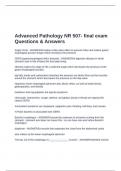Advanced Pathology NR 507- final exam
Questions & Answers
Angle of His - ANSWERSCreates a flap valve effect to prevent reflux and makes gastro
esophageal junction longer which increases the pressure
GERD (gastroesophageal reflux disease) - ANSWERSA digestive disease in which
stomach acid or bile irritates the food pipe lining.
Obesity makes the angle of His a widened angle which decreases the pressure at the
gastro esophageal junction
big fatty meals and carbonation stretches the stomach out which thins out the muscles
around the stomach which decreases the pressure on the flap valve
Hypotonic lower esophageal sphincter also allows reflux, as well as hiatal hernia,
gastroparesis, and obesity
heartburn and regurgitation are typical symptoms
chest pain, hoarseness, cough, asthma, and globus (lump in throat) are atypical for
classic GERD
Associated symptoms are dyspepsia, epigastric pain, bloating, belching, and nausea
H.Pylori bacteria is associated with GERD
Barrett's esophagus - ANSWERScaused by exposure to enzymes coming from the
stomach - stomach acid does not cause this - so can have non-acid reflux Barrett's
esophagus
diaphram - ANSWERSa muscle that separates the chest from the abdominal cavity
also makes up the lower esophageal sphincter
The top 1/3 of the esophagus is ______________ muscle. - ANSWERSskeletal muscle
,the middle of the esophagus muscle is made up of...muscle - ANSWERSskeletal and
smooth muscle
the bottom 1/3 of the esophagus is made up of....muscle - ANSWERSsmooth muscle
simple obstruction of the GI tract - ANSWERSresult from the blockage of the intestine.
Causes of simple obstructions include adhesions, hernias, tumors, or even ingestion of
inorganic objects that become lodged within the intestine.
intussusception, or the telescoping of the intestinal wall onto itself, is more common in
children less than 2 years of age,
surgical adhesions are more common in adults.
Ingestion of objects that result in simple obstructions are more common during the
toddler years.
Functional obstructions occur because of a lack of gut motility, such as during a
paralytic ileus
peptic ulcer disease - ANSWERSulcer formation in the GI tract that affects the lining of
the stomach (gastric ulcer) or duodenum (duodenal ulcer) or lower part of the
esophagus (esophageal ulcer)
form due to gastric acid and pepsin and the breakdown of the stomach lining
Risk factors for developing PUD include:
NSAID use.
Age greater than 65 years.
Genetic predisposition.
Alcohol ingestion.
the role of the stomach - ANSWERSto liquify food by churning it and using enzymes
and acid to assist in the breakdown
pylorus - ANSWERSa muscle like structure that squeezes food down into the
duodenum
can become scarred and lead to obstruction with gastric ulcers
the mucosa layer of the stomach lining - ANSWERSsecrets mucosa rich in bicarbonate
- it protects the lining of the stomach from acid
has gastric pits that contain parietal cells, chief cells, and G-cells
,parietal cells - ANSWERSsecrete HCl (hydrochloric acid) and intrinsic factor
chief cells - ANSWERSsecrete pepsinogen, which is converted to pepsin via the action
of hydrochloric acid
G-cells - ANSWERSreleases gastrin
submucosa - ANSWERSon top of mucosa
contains connective tissue, nerves, and vessels
Muscularis Externa - ANSWERSon top of the submucosa
three smooth muscle layers: aid in peristalysis
serosa - ANSWERSon top of muscularis externa
outer layer of connective tissue that connects to organs
Good and Bad key players in peptic ulcer disease - ANSWERSGood: "defense system"
bicarb = coats and protects cells
prostaglandins = regulates perfusion to stomach and mucus to release bicarb, controls
acid amount secreted by parietal cells
Bad: "toxic system"
ulcer (H. Pylori, NSAIDs, etc) = acid penetrates mucosa = histamine released = parietal
cells release even more HCL acid = more stomach irritation
HCL acid via parietal cells + Pepsinogen via chief cells = pepsin
Heliobacter pylori - ANSWERSspiral shaped bacteria that is the cause of most gastric
ulcers
produces urease which breaks down urea = ammonia & carbon dioxide = neutralizes
acid and breaks down mucosa
spreads through oral/oral or oral/fecal
NSAIDs effect on gastric system - ANSWERSdecreases production of prostaglandins =
impacts the health of the stomach
Zollinger-Ellison syndrome - ANSWERSGastrin-secreting tumor associated with ulcers
= increased stomach acid
signs and symptoms of peptic ulcer disease - ANSWERSIndigestion & epigastric pain
(burning, gnawing or dull)
, Gastric = eating food makes it worse (1-2hrs after), pain = dull & aching, weightloss,
sever: vomit = coffee grounds or frank red blood
Duodenal = eating food makes it better (3-4 hours after), wake in the middle of night
with pain, gnawing pain, severe: tarry dark stool
diagnosing peptic ulcer disease - ANSWERSscope of the stomach
upper GI series: drink barium to coat upper GI tract
CT scan of abdomen with contrast
H. Pylori = blood test, stool test, Urea breath test
Urea breath test - ANSWERSPatient ingests Urea with radio labeled Carbon
Measures exhaled radio labeled Carbon
Complications of peptic ulcer disease - ANSWERSGI bleeding = erodes a hole in
stomach = perforation = peritonitis
bowel blockage @ pylorus from chronic ulceration
increased risk for GI cancer
treatments for peptic ulcer disease - ANSWERSPPIs, H2 receptor blockers, antibiotics,
antacids, bismuth subsalicylates
severe cases with complications: vagotomy, pyloroplasty, gastric resection
vagotomy - ANSWERScutting of certain branches of the vagus nerve, to reduce the
amount of HCL produced by the gut
pyloroplasty - ANSWERSsurgical repair of the pylorus
gastric resection - ANSWERSpartial removal and repair of the stomach
-watch for dumping syndrome = cant regulate movement of food effectively = enters too
fast into intestines = food acts hypertonically pulling water from blood (early) and (late)
rich in carbs & sugar = pancreas releases insulin = hypoglycemia
Chrones disease - ANSWERSA form of inflammatory bowel disease, symptoms include
Crampy abdominal (right lower quadrant area) pain Fever Fatigue Loss of appetite Pain
with passing stool (tenesmus) Persistent, watery diarrhea Unintentional weight loss -
can occur throughout the digestive system - from mouth to anus. Non-continuous
manner = skip lesion
most often found in terminal illium, colon, and other areas of small intestine




